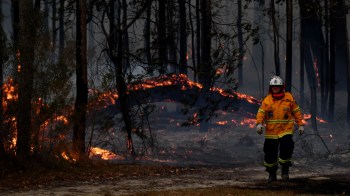Real estate boom and bust in 1910 and 2000: A comparison
“The season of the smiling bank manager.” That’s how author Jonathan Raban describes the 1910s in eastern Montana during the homesteading boom. But he could have been describing the mid-2000s in America during the housing bubble.
Raban’s prize-winning book, Bad Land,captures all the optimism, greed and naïveté that fueled that Montana boom. The reckless lending, too.
Check out our side-by-side comparison of these two booms and busts nearly a hundred years apart… make your own comparisons.
BOOSTERS
1910s: Railroads, the Feds, banks 2000s: Housing developers, lenders, Wall Street
Left: A recruiting brochure produced by the railroads shows a homesteader plowing up gold coins from the eastern Montana soil. (Credit: Mary Dooe/Montana Historical Society) Right: An advertisement from the 2000s encourages people to buy houses with easy loans. (Credit: MarketplaceDollarsAtWork.com)
When Uncle Sam and corporate America put their weight and influence behind an idea, it doesn’t take long for the rest of us to follow.
In the 1910s, the government wanted the West settled. The railroads wanted customers there. Banks wanted to capitalize on their success. In the 2000s, the government wanted to encourage home ownership and stimulate the economy, builders wanted buyers and Wall Street wanted to capitalize on their success.
 Can we afford the consumer economy? Marketplace explores how we consume, what we get from it, what it costs and whether we can keep it up.
Can we afford the consumer economy? Marketplace explores how we consume, what we get from it, what it costs and whether we can keep it up.
Explore the whole series here.
BUYERS
1910s: Landless Americans, immigrants 2000s: Aspiring homeowners, speculators
Left: A cabin in eastern Montana, 1911. Homesteaders were required to build a dwelling at least 12 by 14 feet. (Credit: Evelyn Cameron/Montana Historical Society) Right: A mansion-style house in Silicon Valley, 2005. (Credit: Justin Sullivan/Getty Images)
In 1910, 320 acres of free land sounded “like a vast landholding,” says Bad Land author Jonathan Raban. “But it was just way too small for the kind of mixed farming practiced by the homesteaders.”
Landless Americans and European immigrants swarmed to Montana during that decade. Some wanted to settle there. Others wanted to speculate on what they anticipated would be rising land prices. Raban describes the immigrants as “fresh off the boat from Europe, come to put down roots and put their whole lives into the effort. They built their houses with their bare hands, they didn’t buy them on a subprime mortgage.”
MYTHS
1910s: “Rain follows the plow.” 2000s: Housing prices always go up.
In the early 1900s, theories like “rain follows the plow” passed for serious science, Raban says. That’s the idea that the mere act of farming the land would increase rainfall. People even believed rain followed the disturbance of electrical current caused by building the railroads. Sounds crazy now, but in our recent housing bubble we had our own myths — a lot of people thought house prices would never fall. Farmers in the 1910s also clung to “modern” dryland farming techniques that ultimately didn’t pan out. Neither did our newfangled credit default swaps.
MONEY
1910s: Low interest rates, easy loans 2000s: Low interest rates, refinancing, subprime mortgages
Left: An ad for loans in Montana in the 1910s. (Credit: Mary Dooe/Montana Historical Society) Right: A model home in a new subdivison in suburban Virginia, 2003. (Credit: Mike Theiler/Getty Images)
Raban says banks doled out loans left and right in 1910s Montana.
“Homesteaders needed tools and material to build their cabins and farmhouses, fencing equipment, plows and seed,” he says. “Many paid off their loans and took on new ones to pay for cars and advanced farm machinery.” They became over-leveraged, in modern terms, and a lot of 21st century McMansion buyers could probably relate.
BUSTERS
1910s: Drought 2000s: Collapse of mortgage derivatives
Left: An abandoned homestead in eastern Montana. (Credit: Sarah Gardner/Marketplace) Right: Model homes sit vacant in the center of a suburban California development where construction was halted in November 2008. (Credit: Justin Sullivan/Getty Images)
What caused the Montana homestead boom to bust? World War I ended and wheat prices fell. The “rainy years” ended. Normal conditions returned: drought. Farms were foreclosed on. Banks went belly up. Most of the homesteaders, Raban says, “couldn’t even feed their families and ‘starved out,’ moving on with little more than the clothes on their backs.”
In 2007, a wave of mortgage defaults pulled the legs out from under an already shaky mortgage derivatives market. Soon after, housing prices collapsed. Homes were foreclosed. Banks failed. And homebuyers? You know the rest of the story.
There’s a lot happening in the world. Through it all, Marketplace is here for you.
You rely on Marketplace to break down the world’s events and tell you how it affects you in a fact-based, approachable way. We rely on your financial support to keep making that possible.
Your donation today powers the independent journalism that you rely on. For just $5/month, you can help sustain Marketplace so we can keep reporting on the things that matter to you.


















